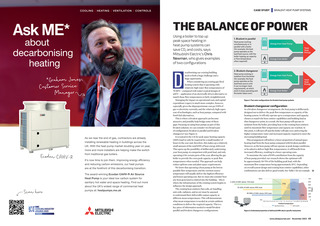


CASE STUDY | BIVALENT HEAT PUMP SYSTEMS THE BALANCE OF POWER D ecarbonising our existing building stock is both a huge challenge and a huge opportunity. When considering an existing gas-fired heating system that is operating with relatively high water flow temperatures of 70-80oC compared with todays typical designs of 55oC application of an electrically driven alternative to match those flow temperatures is fairly straightforward. Managing the impact on operational costs and capital expenditure (capex) is much more complex, however, especially given the disproportionate cost per kWh of gas vs electricity currently, and the relatively high capex cost of technologies, such as heat pumps, compared with fossil-fuel alternatives. This is where a bivalent approach can become attractive and possibly help bridge some of these gaps. Focusing on using heat pumps as part of this bivalent solution, we can consider two broad types of configuration: bivalent in parallel and bivalent changeover (see Figure 1). It is typical in the UK for peak space heating capacity (100% load) to only be required for a small number of hours in the year and, therefore, this makes up a relatively small amount of the total kWh of heat energy delivered. This opens up the possibility of deliberately undersizing your heat pump, in comparison with peak load, and only operating it for certain parts of the year, allowing the gas boiler to provide the extra peak capacity or peak flow temperatures when needed. This approach can help reduce upfront costs and plant space requirements. We know that operating a heat pump at the lowest possible flow temperature and the warmest source temperature will usually deliver the highest efficiency and lowest operating cost. But we must also consider how any heat generated is emitted into the building this is where the infrastructure of the existing system begins to influence the design approach. The existing heat emitters (fan coils, air handling unit coils, radiators, and so on) must be assessed to understand their deliverable output capacity at different mean temperatures. This will demonstrate what mean temperature is needed at certain ambient conditions to deliver the required capacity. This is a key piece of information needed to model bivalent parallel and bivalent changeover configurations. 1. Bivalent in parallel Heat pump working simultaneously or in parallel with a boiler (for example, the heat pump operates as the lead heat source, with the boiler topping up capacity or flow temperature when required) 2. Bivalent changeover Heat pump working in isolation from the boiler (for example, the heat pump operates as the lead heat source until it can no longer meet requirements, at which point it stops operating and the boiler takes over) Figure 1: Two main configurations for bivalent heat pump systems Bivalent changeover configuration In a bivalent changeover arrangement, the heat pump is deliberately designed not to deliver the peak flow temperature or capacity of the heating system. It will only operate up to a temperature and capacity chosen to match the heat-emitter capabilities and building load at that changeover point.As a result, the heat pump will operate in isolation from the boiler, providing heat to the existing heat emitters until its maximum flow temperature and capacity are reached. At this point, it will turn off and the boiler will take over, delivering the higher-temperature water and increased capacity required to meet the increasing building load. This arrangement will deliver a lower proportion of annual space heating load from the heat pump compared with bivalent parallel. However, as the heat pump will not operate at peak design conditions, or be asked to deliver high flow temperatures, it will benefit from increased efficiency, resulting in a lower operating costs. To maximise the ratio of kWh contribution from the capacity of heat pump provided, our research shows the optimum will be approximately 50-75% of the building peak load, with the maximum flow temperature being approximately 55oC. Depending on overall system design and existing heat-emitter capabilities, other combinations can also deliver good results. See Table 1 for an example 100% 700 600 500 400 300 Hours Using a boiler to top up peak space heating in heat pump systems can save CO2 and costs, says Mitsubishi Electrics Chris Newman, who gives examples of two configurations 200 100 0% -10 -9 -8 -7 -6 -5 -4 -3 -2 -1 0 1 2 3 4 5 6 7 8 9 10 11 12 13 14 15 0 Ambient temperature operational Hours Heat Load% Figure 2: Estimated proportion of delivered kWh above specific load points www.cibsejournal.com November 2023 43